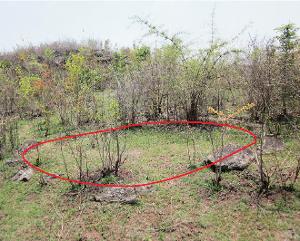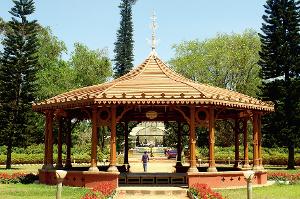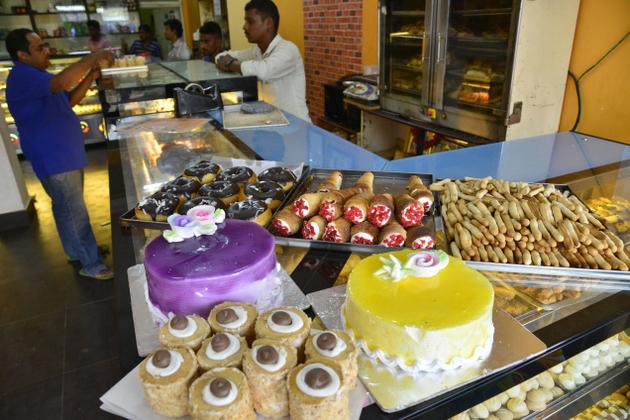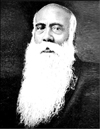If there was one constant refrain in the last ten days in Mysuru it was “Are you attending the royal wedding, did you get the invitation?” This was to witness a historic wedding after 40 years when the titular head Yaduveer Krishnadatta Chamaraja Wadiyar tied the knot on June 27, 2016. The royals from different parts of the country had descended to watch the six-day wedding in all its pomp and glory. Rajmata Pramoda Devi Wadiyar had planned the whole marriage to perfection that was watched by the whole world on their television screens and the lucky few in the opulent, magnificent Mysore Palace. The focus was also on the beautiful bride Trishikha Kumari Singh and her father Maharaja Kumar Harshavardhan Singh of Dungarpur and mother Rajkumari Maheshree Kumari.
After the six-day wedding, Star of Mysore caught up with a relaxed Harshavardhan Singh at Hotel Radisson Blu. The handsome Mr. Harshavardhan Singh, 60, was sitting relaxed in the lobby of the hotel after participating in the six days of hectic wedding rituals of his daughter. He was very articulate, witty and spoke at length about the wedding, the wonderful preparations made by Rajmata Pramoda Devi Wadiyar, about the young, newly-married couple, about whether it was love marriage or an arranged one, his entry into politics as the Rajya Sabha MP and how he has fallen in love with Mysuru. Excerpts.

by N. Niranjan Nikam, Senior Journalist
Star of Mysore (SOM): Sir, just as Mysuru is in the Southern-most part of Karnataka, Dungarpur is a city in the Southern-most part of Rajasthan. The coincidence begins from here. You also have a grand legacy like the Wadiyars. How do you feel about the union of the two Princely families?
Harshavardhan Singh: Well, I feel very elated and happy that we are being part of the great Wadiyar dynasty. This is the first time we have come to the South. We had never gone South to find brides or grooms from Dungarpur. Our relations have always been with the Royal families of Madhya Pradesh, Gujarat and Rajasthan, like the Royalty of Bharathpur.
SOM: The match between Yaduveer and Trishikha, as everyone gushes, is a match made in heaven? As Mysureans we are very proud of our titular head of Wadiyar dynasty. What is the reaction in Dungarpur?
Harshavardhan Singh: Everyone is happy in our city also like they are happy here. I am getting calls from all over India. There is lots of excitement and this marriage is covered in all Rajasthan newspapers and a very prominent national newspaper carried the wedding photograph on their front page in their Delhi edition. I am also happy that Star of Mysore has covered this historic wedding very well.
SOM: Rajmata Pramoda Devi Wadiyar as we all know has planned the whole wedding meticulously and the whole world is a witness to it. What has been your experience in the last seven days?
Harshavardhan Singh: Well, it has really opened our eyes. We also follow the rituals and other ceremonies in our families. But it will last for just two or three days and a couple of hours each day. However, what we saw here was the Wadiyar dynasty culture and tradition being kept alive to the last detail. Madam has planned everything so well that every day the rituals were conducted according to the family traditions and it began in the morning and went on till the evening. That is how it should be; one must maintain our culture and traditions like visiting the temples for puja. I must tell you that both Yaduveer and Trishikha are also fully aware of the traditions and I am sure they will also keep it alive. They are young but still very mature. I have no words to thank Mrs. Wadiyar for all the wonderful arrangements she has made. We are all going back with very fond and ever-lasting memories.
SOM: There is a confusion about whether this is a love marriage or an arranged marriage. As the father of the bride, please clarify once and for all what it is?
Harshavardhan Singh: I am glad you asked me this question because there is so much being written about it. It is not a love marriage. Trishikha’s mother’s younger sister is married to Kamakshi Devi’s (daughter of the late Maharaja Jayachamarajendra Wadiyar) son. Hence, there is already a Mysuru connection among us. Yaduveer and Trishikha would meet on social occasions. When we were looking for a boy for our daughter, she said that she would not mind marrying Yaduveer. We knew Swarup Anand Gopal Raj Urs and Leela Tripurasundari Devi (biological parents of Yaduveer). We approached them. But they said that it was too early as their son was studying in the US.
After a lot of convincing they agreed but still said they had to think about it as the horoscopes (Janampatti) had to match. There are about 34-36 points which have to match and there is the ex-amount of marks for that. Luckily, they matched. However, you must also remember that first Yaduveer had to agree to the match. Again, luckily he also did. Then we have what is called ‘Roka’ which means ok or in other words you have locked it in (laughs loudly). This happened in 2013. The late Highness Srikantadatta Narasimharaja Wadiyar came to the engagement and also hosted a dinner for us at the Bangalore Palace with the band playing. We were just beginning to get to know him. He had attended one of our relative’s wedding in Mount Abu. It was a tragic shock for all of us. But Her Highness has very bravely withstood the shock and then adopted Yaduveer. I came for the adoption ceremony, but I was not able to come to the coronation as we were opening a museum in Dungarpur.
You must remember that my Sambandis (He asked for an equivalent word in Kannada and I told him that it is Beegaru which he then kept repeating) have changed between the engagement and marriage. If it was Swarup and Leela when the engagement took place it is now Her Highness. It must be a very unique occasion that has happened. I reiterate that it is an arranged marriage and not a love marriage.
SOM: Yaduveer has captured the hearts and minds of the younger generation and the people of Mysuru and it is just a matter of time before Trishikha also does. Do you want to give any advice to them?
Harshavardhan Singh: You are sitting on a very high pedestal. People have lots of expectations from you. This is a very huge responsibility. There are lots of problems. I would tell them, keep life simple and be grounded. But, I know that the young couple are very mature and grounded and they will rise to the occasion.
Theirs is more of an intellectual match. He studied economics and she used to lecture on a few subjects in her class. Both read a lot of books. Hence, I don’t think I need to give them any advice at all.
SOM: You have been elected as the Rajya Sabha Member as a BJP candidate. Why did you seek to be a member of the Upper House?
Harshavardhan Singh: I didn’t seek the membership. I have never sought it. It was a pleasant bolt from the blue, so to say. I have been a great supporter of Rajasthan Chief Minister Vasundhara Raje and a great fan of our Prime Minister Narendra Modi and also Amit Shah.
Unlike many who try for the Rajya Sabha membership, I did nothing. My grandfather, the last Princely ruler of Dungarpur, Maharwal Shri Lakshman Singh Bahadur was elected to the Rajya Sabha in 1952. He was also a four-time MLA. He was in State politics and became the Speaker.
Probably because of all this I have been chosen, thanks to the CM. The area I come from is a tribal area. I have been chosen because it is reserved for the tribes. I belong to the Swara Jathi. It is an upper caste. This is my first time in politics. People of Dungarpur have lots of expectations. You must see the interest and the adulation that people accord me.
My grand uncle, Dr. Nagendra Singh was the President of the International Court of Justice, The Hague and also one of the persons involved in framing the Constitution. My uncle the late Raj Singh Dungarpur (my father’s younger brother) was the President of the Board of Control for Cricket in India. We all love sports and I play cricket, squash and tennis.
SOM: That means both your son-in-law and you are charting the same path?
Harshavardhan Singh: Yes, we are on a similar journey. We now have to brace it out and both of us have two responsible postings (smiles).
SOM: Will you influence your son-in-law to enter politics since he has shown his inclination?
Harshavardhan Singh: I will not influence him. I will never do it (he tells very emphatically). I don’t think Yaduveer will enter politics. He has lots of responsibilities and he has to look after many things. Of course, Her Highness is there to guide him through. He may be interested in politics. Being interested and getting into it are two different things. Most Indians are interested in politics and that is why you cannot take the electorate for granted. Even the very poor know how to vote. Hats off to the Election Commission for doing a great job. The corruption and booth rigging have more or less come down.
SOM: The Royalties in the North, especially from Rajasthan and Madhya Pradesh and a few other States have always had a better deal from the respective governments, unlike in Karnataka where people feel the Wadiyars have not been treated so kindly. Will this change now?
Harshavardhan Singh: I hope so. In Karnataka, Mysuru is the only State, unlike, in Rajasthan where we have so many States and hence there used to be many rulers.
There is no doubt that the Wadiyars have been treated unkindly in spite of their immense contribution to the State. There are lots of heritage properties in India, which only the Royals know how to maintain. The criticism against the Royals is that all they were interested in is girls, wine and song. Only Princes know how to look after the heritage. It is an inseparable part of their life.
SOM: The kings among hoteliers Maharana Arvind Singh Mewar and Maharajah Gaj Singh of Jodhpur were some of the distinguished guests at the Royal wedding. Have the Dungarpur Royals also been inspired to start hotels?
Harshavardhan Singh: Maharaja Kishangarh is also a big name in the hotel industry, though he was not present at the wedding.
I started the Udai Bilas Palace Hotel in Dungarpur in 1993 and it is doing quite well. It is the only heritage hotel in that part of a 100 km stretch. It is close to Gujarat and however, in Rajasthan, tourism has been given a big boost. The poorest of Rajput has become a tourist guide and is earning well. He also runs a home stay. I only hope that the Mysuru Royal family gets back its properties.
Coming to Mysuru, the more I see of it, I fall in love with it. You have such a nice Race Course and inside it a Golf Course, boulevards built during Nalwadi Krishnaraja Wadiyar’s time, you feel like you are in Europe. It is a clean and green city, a heritage city with lovely gardens and it has a good education system.
SOM: What is the emblem that is carried on your business card?
Harshavardhan Singh: The emblem or the crest depicts two tribals holding the shield with Hanuman inside carrying the Sanjeevini, the chink (antelope) on the top and with the motto inscribed “Nyayam Chirajayam,” meaning Justice for All.
SOM: After the wedding reception in Bengaluru on July 2, will you host a reception in Dungarpur?
Harshavardhan Singh: A few reports have said that I will be hosting a reception in Delhi. It is not true. You can’t go on and on. Her Highness has already done the best in hosting this wedding.
I have got both my daughters married off. My elder daughter Shivatmika is married to Tikka Saheb Jaideepsinhji Mandhattasinhji, the grandson of HH Thakore Saheb Shri Manoharsinhji Pradyumansinhji of Rajkot, last year in January.
source: http://www.starofmysore.com / Star of Mysore / Home> Feature Articles /by N. Niranjan Nikam, Sr. Journalist / July 02nd, 2016








